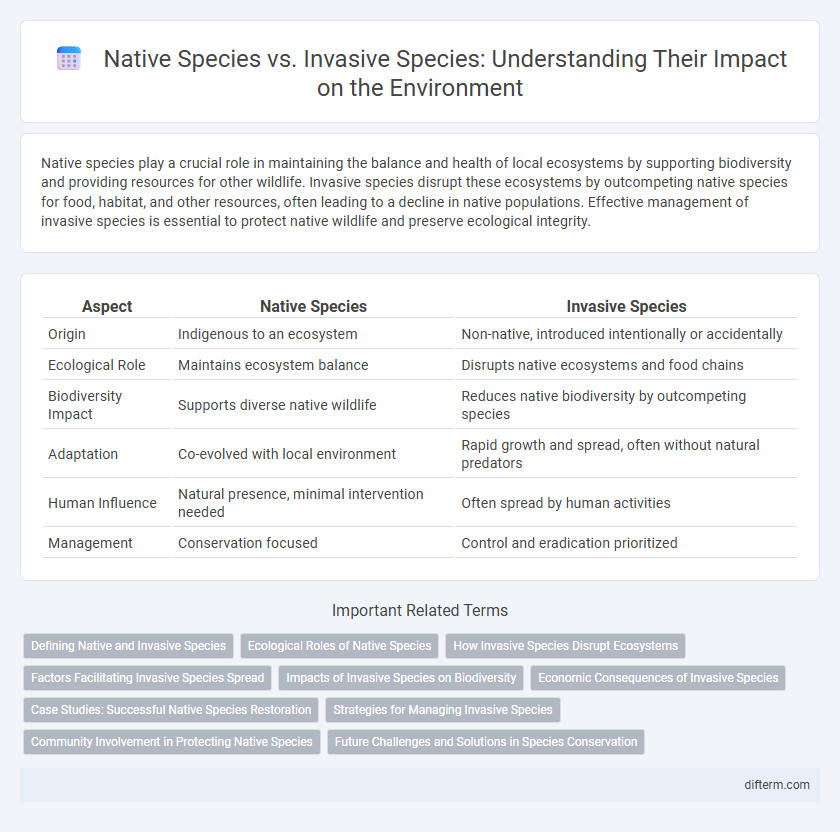Native species play a crucial role in maintaining the balance and health of local ecosystems by supporting biodiversity and providing resources for other wildlife. Invasive species disrupt these ecosystems by outcompeting native species for food, habitat, and other resources, often leading to a decline in native populations. Effective management of invasive species is essential to protect native wildlife and preserve ecological integrity.
Table of Comparison
| Aspect | Native Species | Invasive Species |
|---|---|---|
| Origin | Indigenous to an ecosystem | Non-native, introduced intentionally or accidentally |
| Ecological Role | Maintains ecosystem balance | Disrupts native ecosystems and food chains |
| Biodiversity Impact | Supports diverse native wildlife | Reduces native biodiversity by outcompeting species |
| Adaptation | Co-evolved with local environment | Rapid growth and spread, often without natural predators |
| Human Influence | Natural presence, minimal intervention needed | Often spread by human activities |
| Management | Conservation focused | Control and eradication prioritized |
Defining Native and Invasive Species
Native species are organisms that have naturally evolved and adapted to a specific ecosystem over thousands of years, playing a crucial role in maintaining ecological balance. Invasive species, often introduced by human activities, disrupt these ecosystems by outcompeting native flora and fauna, leading to biodiversity loss and altered habitat conditions. Understanding the distinction between native and invasive species is essential for effective conservation and ecosystem management.
Ecological Roles of Native Species
Native species play crucial ecological roles by maintaining ecosystem balance through their long-established relationships with other organisms, such as pollinators, predators, and decomposers. Their presence supports biodiversity, nutrient cycling, and habitat stability, which invasive species often disrupt by outcompeting or preying on native populations. Protecting native species helps preserve ecosystem resilience and function, ensuring sustainable environmental health.
How Invasive Species Disrupt Ecosystems
Invasive species disrupt ecosystems by outcompeting native species for resources such as food, water, and habitat, leading to a decline in biodiversity. They often lack natural predators in new environments, allowing their populations to grow unchecked and alter ecological balance. These disruptions can result in the loss of native species, changes in soil composition, and altered nutrient cycles, severely impacting ecosystem health and resilience.
Factors Facilitating Invasive Species Spread
Invasive species spread rapidly due to factors such as high reproductive rates, absence of natural predators, and adaptability to diverse environments. Human activities like global trade, habitat disturbance, and climate change further accelerate their distribution, outcompeting native species. Effective management requires understanding these facilitators to protect biodiversity and ecosystem stability.
Impacts of Invasive Species on Biodiversity
Invasive species disrupt native ecosystems by outcompeting endemic species for resources, leading to declines in biodiversity and altering habitat structures. These alien organisms often introduce new diseases, predate on native species, and change nutrient cycling processes, causing long-term ecological imbalances. The loss of native species diversity compromises ecosystem resilience and reduces the ability to provide essential services such as pollination and water purification.
Economic Consequences of Invasive Species
Invasive species cause significant economic losses by damaging agriculture, fisheries, and forestry industries, leading to billions of dollars in control and management costs annually. Native species disruption results in decreased ecosystem services, affecting pollination, water quality, and soil fertility, which further impacts economic productivity. Governments and industries face increased expenses in restoration efforts and reduced revenue from impaired natural resources.
Case Studies: Successful Native Species Restoration
Restoration projects in the Florida Everglades highlight the resurgence of native species such as the American alligator and wading birds after invasive species like the Burmese python were controlled. Similarly, Australia's removal of invasive cane toads facilitated the recovery of native predators including quolls and red-bellied black snakes. These case studies demonstrate how targeted invasive species management strengthens biodiversity and ecosystem resilience.
Strategies for Managing Invasive Species
Effective management of invasive species involves early detection through monitoring programs and rapid response teams to prevent establishment and spread. Employing physical removal, biological control agents, and targeted chemical treatments can reduce invasive populations while minimizing harm to native ecosystems. Public education and habitat restoration also play crucial roles in supporting native species resilience and maintaining ecological balance.
Community Involvement in Protecting Native Species
Community involvement plays a crucial role in protecting native species by promoting awareness and participation in habitat restoration projects. Local volunteers help monitor invasive species, removing them before they can disrupt ecosystems and outcompete native flora and fauna. Educational programs empower residents to recognize and report invasive species, fostering a collaborative effort to preserve biodiversity and maintain ecological balance.
Future Challenges and Solutions in Species Conservation
Future challenges in species conservation include the accelerating spread of invasive species that disrupt native ecosystems and threaten biodiversity. Effective solutions involve enhancing early detection systems, implementing targeted eradication programs, and promoting restoration of native habitats through community engagement and advanced ecological research. Strengthening international cooperation and adaptive management strategies are essential to mitigate the long-term impacts on native species survival.
native species vs invasive species Infographic

 difterm.com
difterm.com